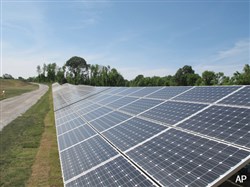VOL. 38 | NO. 25 | Friday, June 20, 2014
TVA’s evolving rules bring turmoil to solar industry
By Hollie Deese
Gary Wolf is chasing the sun from Tennessee to Belize. The owner of SunDog Solar Energy installation company in Nashville says the changes Tennessee Valley Authority made to their Generation Partners renewable energy program means a small rooftop solar company like his can’t survive in Tennessee.
“It’s just not worth it to be in business here,” he says. “You have to go somewhere else.”
The solar industry doles out its share of highs and lows. In Tennessee, small solar companies, particularly ones that work in the residential field, have run into problems on several fronts.
Major solar players like Hemlock Semiconductor in Clarksville haven’t gotten off the ground due to an oversupply in the polysilicon industry, a key resource in building solar power panels.
In addition, Tennessee consumers are hesitant to invest in residential solar insulation because of the recently reduced drop in premium payment for energy output.
Through Generation Partners, the TVA had purchased 100 percent of the green energy output from a renewable generation system equal to the retail rate, plus a 12-cent premium. Now, that premium is 4 cents and will soon be gone altogether.
TVA and small solar
For Wolf and SunDog, one of the main concerns is the cap set by TVA on the amount of residential solar that can be installed. When the cap is reached early in the year, it leaves months when Wolf, and others like him, can do no installation.

Panels containing solar cells make up the new West Tennessee Solar Farm that was officially unveiled to the public in 2012 in Stanton, Tenn. Tennessee’s largest solar generating facility uses its more than 21,000 panels to harness the sun’s energy to output 5 megawatts of power.
-- Ap File Photo/Adrian SainzThe state’s total capacity is set at 10 megawatts – six megawatts commercial, four megawatts residential. It is not enough to sustain the state’s nearly 200 solar companies.
By comparison, Massachusetts has a cap of 400 megawatts, and Georgia’s new Power Advanced Solar Initiative is looking to contract at least 45 megawatts in 2014.
TVA spent about $30 million on small renewable purchase programs, such as solar, wind, biomass and landfill gas, in fiscal 2013, including homes and business, according to Duncan Mansfield, Strategic Communications Consultant at TVA.
He notes that the $30 million was part of $380 million in renewables purchases that year, including wind energy bought under contract from several wind farms in the Midwest, where there is more wind capacity than in the Tennessee Valley.
“TVA must balance the interest of renewable generators to increase TVA’s purchases with the interest of ratepayers to keep TVA’s electric rates affordable,’’ he explains. “There is a fine line between incentives and subsidies.’’
Mansfield says that TVA offered incentives to spur development of renewable generation in the Valley, beginning about a decade ago.
As the industry has grown and costs have come down, TVA has slowly reduced those incentives in line with falling technology costs, he adds.
“Initially the incentives were supported by consumer purchases of renewable energy blocks on their power bills,’’ he explains. “But TVA’s renewable purchases now exceed the amount that comes in from those consumer power purchases.
“Even as incentives go down, interest remains high from renewable providers. As one example, a solar farm planned for West Tennessee that could be the largest solar installation in the Valley when it is finished has signed up to sell power to TVA at market rates with no premium incentives.’’
Wolf, who stopped taking new solar clients in April 2013 after the state’s installation cap was reached, says he’s had enough. He and his wife are selling their Nashville home and moving to Central America. Diversifying his small business just wasn’t an option.
Wolf had worked for Nashville’s Lightwave Solar for three years, starting in 2007. He was one of their first two employees and first crew leader, and he became a certified installer in 2009.
Lightwave owner Steve Johnson agrees that the TVA caps have been hard on smaller businesses.
“By and large, they have had a decent program, but they really don’t get small business, I think,” Johnson says of TVA. “They make a small move, and it kind of squashes installers and solar designers.”
Solar coaster’s winners/losers
Dodd Galbreath, founding director and assistant professor at Lipscomb University’s Institute for Sustainable Practice, is confident that solar use in the state, especially among residential users, will continue to grow as prices drop.

Galbreath
“Solar is the most resilient of the renewable technologies out there, the freest available abundant resource that the planet receives every day,” he says.
“Now we are carrying around cell phones with the computing power the Oak Ridge National Lab had during the cold war. It is just going to be a matter of time before it gets cheaper.”
He installed solar panels on his house six years ago, and the gross total was around $50,000. Two and a-half years later it was $25,000, and when he priced it this year, it was $7,500 with installation costs.
“That being said, it [solar] is generally the last choice because of the return on investment initially,” Galbreath explains. “Fortunately and unfortunately, the Chinese were not only able to figure out how to provide cheaper labor to produce it, but they also figured out how to scale it from a manufacturing perspective and greatly reduce the cost.”
‘Perfect environment’
For Galbreath, the solar incentive was enough to offset expensive installation costs at his home that have to be paid up front.
“Because of the size of my roof and my upfront costs, I could only afford to put in half of my demand,” Galbreath says. He has been grandfathered in on the initial 12-cent premium rate for now.
“My panels generate half of the electricity I use, on average, but the premium payment provides 90 percent of my expense. My electric bill is $100 a year, and it is a 3,800-square-foot house,’’ he explains.
“Because we are getting that premium price and selling it for higher than we pay for it, it costs a lot less than the amount of electricity that we actually need.”
Galbreath is generating four kilowatts of electricity, and if he adds three more he will be 100 percent renewable.
This isn’t an option for all homeowners who need their home to have a southern exposure and roof pitches at just the right angle to get the full benefits of the sun.
“My house is really tall, faces almost due south, and any trees will never get tall enough to cover the roof, so I have the perfect environment,” he says. “But not everybody has that.”
Polysilicon and price
Price reductions also have come from the plummeting price of polysilicon.
It’s those plummeting prices that have attributed to the lack of completion of Wacker Chemical, which broke ground in 2011 on its $2 billion dollar plant outside Charleston, just north of Cleveland, Tennessee, and makes polysilicon.
In 2012, the company announced an 18-month delay in production because of over-capacity for polysilicon. Work should be complete on the plant in 2015.
And while construction still continues, albeit slowly in Cleveland, after years of construction by Hemlock Semiconductor in Clarksville, $100 million for infrastructure improvements from the state and more than $11 million in job training grants, production just stopped.
“There were bubbles we are still working through in terms of over production and over capacity relative to the demand of the market,” says John A. Hopkins, Ph.D, director of strategic operations at the University of Tennessee Knoxville.
“There have been ups and downs, a roller coaster in terms of the overall markets along the supply chains.”
Hopkins says that while there have certainly been losers on the solar roller coaster, there have been some winners, including Shoals Technology Group in Portland, Tennessee.
“There has been a lot of shakeout and the dust hasn’t settled yet, but overall the trend is upward,” he explains. “It wasn’t as steep as it was five years ago, but it is still very steep in terms of the growth rates.”
Rise of farms
One area in solar that is growing in the state: Large-capacity solar farms.
The University of Tennessee manages the 5-megawatt West Tennessee Solar Farm 50 miles east of Memphis in Haywood County, which was built by Chattanooga’s Signal Energy in 2011 and connected to the electrical grid in 2012.
It is one of the largest solar-generating facilities in the Southeast at 25 acres, and its 21,000 solar panels produce 5 million watts of electricity annually.
That electricity is distributed through purchase agreements with local utility Chickasaw Electric Cooperative and Tennessee Valley Authority.
“It demonstrates new technologies and provides a place for developing and proving out new ideas and innovations in solar energy, and to educate and provide an outreach for the public and students,” Hopkins says.
Two other solar farm plans were announced in August 2013 near Selmer in McNairy County for 160,000 solar panels to be spread over parts of 326 acres, with a total output of 40 megawatts. Each would be four times larger than the one in Haywood County.
Wasted skills
Wolf says the problem with building solar farms is that it is more akin to a general factory job than workers trained for the solar industry.
“They are finding jobs on the solar farms that they are way over-trained to do,” he says. “Your average construction company can put up a solar farm, but that doesn’t necessarily mean it’s going to be done well. There is a mismatch of what we’re training these people to do.”
Wolf left Lightwave in 2010 to create a solar installer training program at the Tennessee Technology Center at Dickson, now the Tennessee College of Applied Technology. Of the school’s 27 outposts, two have solar, Dickson and Pulaski.
“When I taught solar, we had more students than there were jobs,” he says. “Now, the current teacher says it’s the opposite. He only has four students, but there’s work on the solar farms.
“It’s a total mismatch of training and employment opportunities, but at least the solar boom is providing jobs. Just not the ones I’d thought would happen.”
Despite the move, Wolf is nowhere near done with the sun, just moving to where it takes him.
“I’ve shifted from doing residential and small commercial installations to consulting and operations and maintenance for Vis Solis, a larger solar company,” he says.
The Franklin-based company has contracted him to handle installations of several large systems in Georgia and one in the Philippines.
“They can’t find any work in Tennessee,” Wolf says. “It’s a loss for the Valley.”